The Economics and Statistics Division maintains archives of previous publications for accountability purposes, but makes no updates to keep these documents current with the latest data revisions from Statistics Canada. As a result, information in older documents may not be accurate. Please exercise caution when referring to older documents. For the latest information and historical data, please contact the individual listed to the right.
<--- Return to Archive
For additional information relating to this article, please contact:
May 02, 2018PROVINCIAL GDP BY INDUSTRY 2017 The preliminary estimates of economic growth for the provinces and territories in 2017 were released today by Statistics Canada. This data on the growth of the economy is measured at the industry level with chained 2007 dollars at basic prices (sellers' prices before taxes less subsidies on products) that removes the effect of price changes.
In 2017, Nova Scotia real GDP grew 1.2 per cent, the fourth consecutive year of growth. The goods-producing sector expanded by 0.3 per cent and service-producing industries grew by 1.5 per cent.
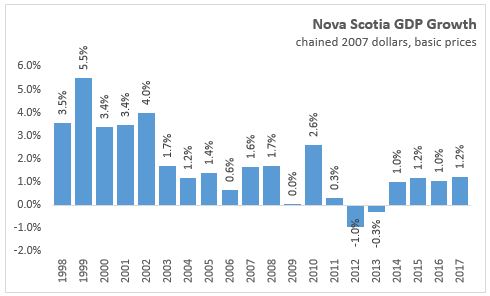
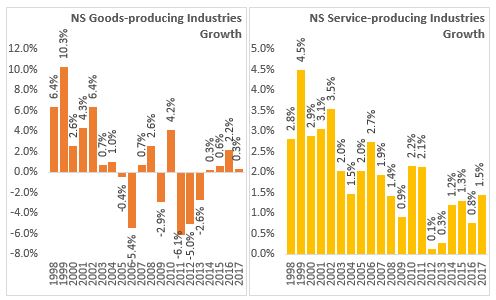
The goods-producing sector grew 0.3 per cent and contributed 0.06 percentage point to overall growth in 2017. Mining, quarrying and oil and gas extraction accounted for the largest negative contribution to growth with conventional oil and gas extraction declining 51.0 per cent due to lower production at offshore projects. Mining and quarrying (except oil and gas) partially offset the decline in the sector with growth of 45.3 per cent as there was new production from gold and coal mining and an increase in non-metallic mineral mining and quarrying from the introduction of new product line at the Cabot gypsum mine. The agriculture, forestry, fishing and hunting sector was down 3.0 per cent with declines across all three of the subsectors. Construction GDP increased 2.3 per cent with an increase in residential activity of 4.9 per cent, a decline in non-residential building construction with the completion of the Nova Centre, and engineering construction rising 4.1 per cent with increased work on the Maritime Link project. Manufacturing GDP grew for the third consecutive year, increasing 2.9 per cent with gains in plastics and rubber products, ships and boat building, and chemical products offsetting declines in food products, fabricated metal products, and wood products.
Service-producing industries GDP grew by 1.5 per cent and contributed 1.16 percentage points to the overall growth rate in 2017. Real estate and rental and leasing (including the imputed value of owner-occupied dwellings) grew at its fastest pace since 2012 with an increase 2.4 per cent and was the largest contributor to growth in 2017. Wholesale trade rebounded from three consecutive years of decline with growth of 5.6 per cent spread across most of its subsectors. Retail growth of 3.7 per cent was due to an increase in activity in all areas except gasoline stations and non-store retailers. Transportation and warehousing expanded 3.3 per cent with increased truck and air transportation but less activity with natural gas pipelines. Professional, scientific and technical services had growth of 2.5 per cent with another year of strong growth in the computer systems design and related service subsector. Offsetting the expansion in the business services sector were declines of less than one per cent in information and culture (-0.9%), finance and insurance (-0.6%), administration and support, waste management and remediation services (-0.9%), and accommodation and food services (-0.5%). Real GDP increased for educational services (+0.9%), health care and social assistance (+1.5%) and declined for public administration (-0.4%).
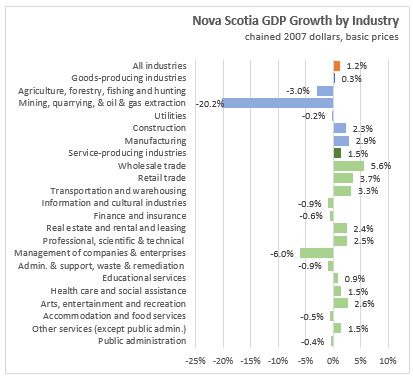
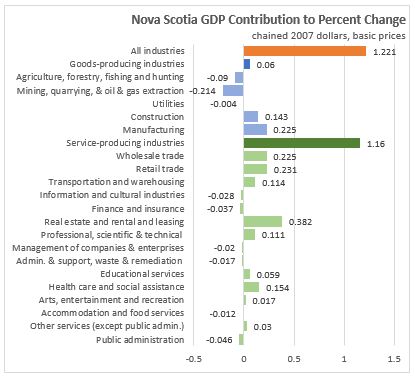
All provinces reported positive growth in both their goods-producing and service-producing sectors in 2017. Newfoundland and Labrador reported growth of 2.1 per cent in 2017 following growth of 1.7 per cent in 2016 on an increase in oil and mining production, construction of the Muskrat Falls electric power project, and higher manufacturing output. Prince Edward Island grew 3.2 per cent with strong residential building construction, higher manufacturing, and a good tourism season. New Brunswick GDP was up 1.8 per cent with gains in construction, manufacturing, wholesale/retail, and transportation. Quebec had its strongest growth since 2000 at 3.1 per cent. Ontario GDP was up 2.8 per cent with services-producing sector accounting for more than 80 per cent of growth, but transportation equipment manufacturing GDP (-5.0%) declining due to an assembly plant strike and changes to certain models being manufactured in Canada. Manitoba GDP growth of 2.9 per cent was broad based across 17 of 20 industrial sectors with strong growth in construction and crop production. Saskatchewan growth of 2.9 per cent follows on declines the previous two years was due to higher oil and gas, potash, and manufacturing output. Alberta led the provinces with growth of 4.9 per cent following declines 3.9 per cent in 2015 and 3.6 per cent in 2016, the energy sector was up 12.7 per cent with a recovery in oil prices. British Columbia GDP increased 3.9 per cent with growth in the services-producing sector of 3.6 per cent and 5.1 per cent in the goods-producing industries.
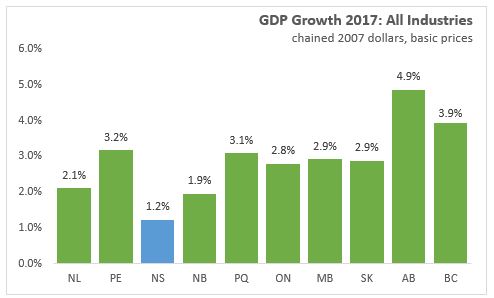
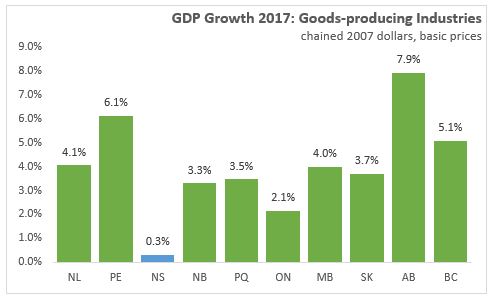
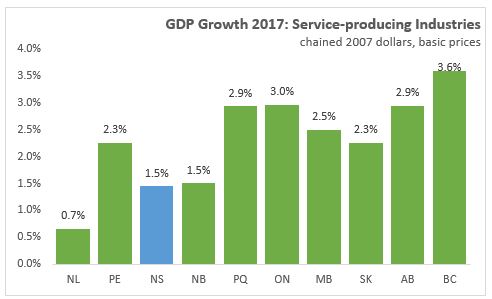
Note: GDP by Industry data provides an industry-level snapshot of economic activity in different sectors of Nova Scotia's economy. Estimates are provided for 2017 without revisions to previous years. Revised estimates for 2015 to 2017 will be published in November 2018. To view Statistics Canada release click here.
<--- Return to Archive